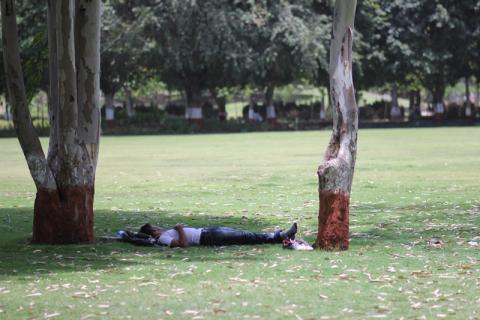Le module est validé, il peut être inséré dans un article pour être consulté par les internautes.
Le différend est loin d’être réglé puisque l'apurement des comptes fâche aussi. « Delhi n’a payé qu’un milliard de roupies sur les cinq et demi qu’ils doivent. Ils ne sont donc pas en mesure de réclamer quoi que ce soit. » Au Delhi Jal Board, on se refuse à tout commentaire sur ce volet financier. Ce casse-tête coûte, quoi qu’il arrive, très cher au gouvernement de Delhi. « On a construit trois réservoirs supplémentaires destinés à contenir l’eau économisée avec le CLC, explique Sanjam Cheema. Mais ils ne servent à rien pour le moment. »
Rajeev Verma préfère ironiser. « Delhi a construit ces réservoirs sans même nous avertir. S’ils nous l’avaient dit, on aurait pu les prévenir qu’ils seraient inutiles… » Pour trouver une issue à cette querelle interminable, l’Upper Yamuna River Board encouragé par un groupe de ministres fédéraux a proposé sa médiation. Delhi attend beaucoup de cette intervention.
Mais le rôle de de l’UYRB reste modeste, comme l’explique HK Sahu : « Je ne dirai pas que Delhi a raison, ni que l'Haryana a raison, ni même que la Cour suprême a eu raison. Je ne suis là que pour faire respecter l’arrêt de 1996 et faire en sorte que les choses se passent du mieux possible. »
En attendant un hypothétique dénouement, Delhi et l’Haryana pourraient prochainement expérimenter un nouvel objet de conflit. Les six Etats riverains de la Yamuna ont entrepris la construction, au nord du pays, d’un nouveau réservoir de stockage des eaux de la mousson. Delhi espère en être la seule bénéficiaire. Ni l’Haryana, ni les autres Etats, n’entendent lui faire cette concession.
Shahnawaz Alam, Antoine Izambard, Thibaud Métais
A Deshgavan, alors que la plupart des hommes ont gagné les villes de l’ouest du Maharashtra pour chercher du travail, les vieux, les femmes et les enfants tentent de survivre en attendant leur retour, et la pluie.
 Les habitants disposent d'un parc de 14 hectares au coeur de la cité. Photo: Lorraine Kihl/Cuej
Les habitants disposent d'un parc de 14 hectares au coeur de la cité. Photo: Lorraine Kihl/Cuej
Les eaux usées sont intégralement retraitées pour être utilisées dans l'irrigation. En cas de rupture d'approvisionnement en eau potable, un mini centre d'épuration permet de nettoyer l'eau de la nappe phréatique, pompée dans l'un des huit puits du quartier. Outre les tours verre et acier de la cybercité, 8 000 résidences ont été construites pour accueillir, entre autres, ses salariés. Tout a été conçu pour satisfaire leurs besoins à proximité : école, épiceries, équipements sportifs...
Calme et sécurité
« L’avantage de la vie à Magarpatta, c’est qu’elle supprime les problèmes basiques, comme devoir se lever tôt pour faire des provisions d’eau. Mais ce que l'on recherche en venant habiter ici, ce n'est pas tant les services que le calme et la sécurité », assure Jash, un ingénieur de 29 ans venu s'installer à Magarpatta city en octobre. Hormis les aller-retours quotidiens qui le mènent à son travail, il ne quitte presque plus le quartier. « J’ai déjà passé deux-trois mois sans voir une seule fois la ville, je ne supporte plus '' l’extérieur '' : le trafic, la pollution, le désordre. »
Près de 40 000 personnes habitent désormais ce ghetto vert. Des employés des 48 entreprises du site, des étudiants, des femmes célibataires et des militaires retraités.
A Bangalore, la « Silicon valley » du high-tech indien, l’outsourcing informatique montre des signes de ralentissement suite à la relocalisation dans les pays occidentaux de certaines activités. Pas de quoi faire sourciller Manik Sharma, le vice président de la société qui administre le quartier : « Toutes les entreprises sont locataires. Si un secteur ralentit ou s’écroule, d’autres prendront le relais ».
Lorraine Kihl et Thibault Prévost
![20130606-GB [Inde 2013] Remerciements PARTIE 2 DELHI - jamia_logo.jpg](http://www.cuej.info/sites/cuej.info/files/public/styles/large/public/20130606-GB%20jamia_logo.jpg?itok=wXDnEgaV) As the temperature soars, two Indian states are at war again for water.
As the temperature soars, two Indian states are at war again for water.
Haryana and Delhi are the two states bordering each other who have a water conflict since 1996. Yamuna and Vyas rivers are the major sources of drinking water for Delhi. Ganga also contributes for some drinking water to Delhi. But there is a crisis when water level goes down during summer time in river basins. It is aggravated particularly during very hot summers.
In 1996, Haryana filed an affidavit in Supreme Court of India citing incapability to provide water to its neighbouring state Delhi. But the Supreme Court decided against it and compelled Haryana to allocate water for Delhi.
The main conflict of interest between the two states is the total water saving made after the construction of Munak Carrier Line Channel (CLC) which reduced in route seepage losses from 30% to 5% as per the submission of Delhi Jal Board. Carrier Line Channel was built aiming to minimize the en route loss of water flowing from Munak Escape, about 120 Kilometers north to Delhi in Haryana. Delhi constructed three other small scale treatment plants named Dwarka, Bawana and Okhla with future planning to use the collective savings.
Total saving done was sufficient enough to run all three additional plants of capacity 80 Million Gallon per Day (MGD) collectively for which 160 cusec of water required and the total saving is the same. But the government of Haryana refused to share the savings to Delhi. « We are already supplying more than Delhi’s share of water and we don’t have water reservoir for further anymore allocation to Delhi », says Mr. Rajiv Verma, Superintendent Engineer, irrigation department, government of Haryana.
According to the Indian constitution, river water distribution in India is a matter of state affairs. Thus, no court can intervene when it is subject to inter-state river water distribution.
Last year, the situation saw its worst. Government of India constituted a group of ministers committee to look into the matter and to come up with some concrete solution to this dispute. Although a chief minister level meeting was held, but ended with no substantial solutions to clamor.
Delhi Jal Board is waiting for the directions from advisory board of the group of central government ministers. « We invested a huge amount of money for the construction of an efficient Carrier Line Channel to minimize the en route losses and to use the savings, but we are denied our share of savings which can actually run our three small scale treatment plants situated in Dwarka (40 MGD), Bawana (20 MGD) and Okhla (20 MGD) », said Delhi Jal Board PRO, Ms. Sanjam Chima. But the government of Haryana denies that there was no such agreement made before or after the construction of CLC to share savings with Delhi. While the states fight Delhites are struggling for water.
Shahnawaz Alam, Antoine Izambard, Thibaud Métais
 I do not know much about gods; but I think that the river is a strong brown god - sullen, untamed and intractable.
I do not know much about gods; but I think that the river is a strong brown god - sullen, untamed and intractable.
Patient to some degree, at first recognized as a frontier; useful, untrustworthy as a conveyor of commerce; then only a problem confronting the builder of bridges. The problem once solved, the brown god is almost forgotten by the dwellers in cities - ever, however, implacable, keeping his seasons and rages, destroyer, reminder of what men choose to forget. Unhonoured, unpropitiated
by worshippers of the machine. - T. S. Eliot (1888-1965) from Four Quartets
Hindu mythology tells us that river Yamuna is a goddess and the water has the power to wash away sins. However, the 22 kilometers of Yamuna that flows through Delhi is no longer fit for ablutions, divine or otherwise. « The amount of untreated sewage and industrial effluents that are directed towards the river are enough to make it very sick. Today, the state of Yamuna in Delhi is such that the thickness of the waste does not allow it to flow, except in the monsoon months » said Dr. Soni.
4% of the river flows
According to the Central Pollution Control Board (CPCB), only 4% of the Yamuna actually flows through the Capital. Ironically, this stretch is responsible for over 70% of the river’s pollution. The pollution levels of the Yamuna are such that the water is unfit even for bathing. That, however, does not stop slum dwellers from taking a bath in the river. R M Bhardwaj, Senior Scientist, CPCB, explained the limitations of the government while dealing with domestic sewage and industrial effluents disposal. « Water is a state subject. In the capital, we have the most extensive sewage treatment plants (STPs) in place. However, the amount of waste water produced by Delhi does not reach the STPs because of the lack of sewage pipelines », he said.